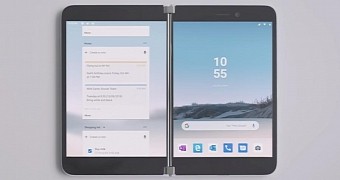The lack of apps is often described as the thing that killed Windows Phone, pretty much because not being able to compete with Android and iOS in this regard is what pushed most people, and developers alike, to these two platforms.
After giving up on both the software and the hardware sides of its mobile strategy, Microsoft decided to make a surprising return last week at the Surface event in New York with the debut of the Surface Duo.
In essence a dual-screen device, Surface Duo is a smaller version of the Surface Neo with one major difference: the operating system that powers the whole thing. Here’s a summary of the October 2 announcements on this front.
First and foremost, Microsoft took the wraps of Windows 10X, a new operating system based on Windows 10 and whose purpose is to power dual-screen and foldable devices. This platform, Microsoft says, should help bring a new product category to the market, with the first such devices expected to launch next year.
And because it has a new operating system, Microsoft wanted to lead the hardware push as well, so Windows 10X is also installed on Microsoft’s own Surface Neo. Projected to launch in 2020, Surface Neo is a dual-screen device that runs Windows 10X and promises full productivity wherever you are, also thanks to a keyboard that you can attach at any time you need faster and more convenient typing.
In addition to Surface Neo, Microsoft also unveiled a smaller dual-screen device called Surface Duo, but this time it’s not running Windows 10X, but Android.
I know this sounds weird, because Microsoft’s dual-screen device should run Microsoft’s dual-screen operating system, but the company most likely decided to go for Android pretty much because a phone needs apps, and right now, Windows doesn’t have these apps.
It’s the lack of apps that I told you about earlier the one that pushed Microsoft closer to the Android world with this often referred to “Surface Phone,” but this doesn’t necessarily mean users are pleased with this new direction of the company.
In fact, some have even started petitions to call for Microsoft to install Windows 10X on the Surface Duo, and the reason that is most often brought forward is the support for UWP apps. And apps in general.
These people claim that by choosing Android, the UWP app concept is pretty much dead, as a universal apps doesn’t eventually end up being universal. So what Microsoft should do is actually install Windows on the Surface Duo and implement Android app support to thus have the best of both worlds.
Pretty much like BlackBerry did many years ago when it decided to add Android app support to BlackBerry OS in an attempt to address the lack of apps dragging down its operating system.
On the other hand, Microsoft is no stranger to this approach. A few years ago, when the software giant was still committed to Windows 10 Mobile, the company actually developed and implemented Android app support in some preview builds of its mobile platform. And everything worked so smoothly, only that for some reason, Microsoft eventually dropped this feature and decided to go for Windows 10 Mobile alone, letting the lack of apps ultimately kill off the platform.
At first glance, it does look like Microsoft should launch a Windows-powered phone running Android, but on second thought, the company is already aware of the challenges of making this happen.
Should Microsoft release a Windows version of the Surface Duo and add support for Android apps? Or should the company stay with Android because UWP apps are dead anyway?
Let us know what you think in the box after the jump.

 14 DAY TRIAL //
14 DAY TRIAL // 